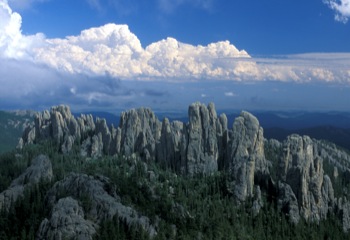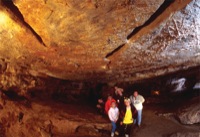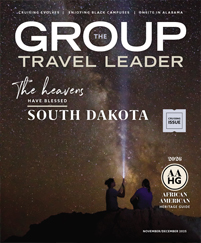
Courtesy South Dakota Tourism
South Dakota’s iconic Black Hills has been used in numerous movies, making its terrain familiar to many.
From a mountainous wilderness in the middle of a prairie to a battleship rising from the earth, South Dakota offers some of the country’s most recognizable national parks and intriguing city attractions.
A Dakota island
The Black Hills area of South Dakota, thought to contain the world’s highest concentration of public parks, monuments and memorials, celebrates democracy, Native American bravery and the wonders of nature.
Nicknamed “island in the prairie” because of the dark ponderosa pines rising against the flat mixed-prairie grass, the Black Hills boasts ancient ties to Native American sacred tribal grounds as well as modern ways to explore the region via the Spearfish Canyon Scenic Byway, the Peter Norbeck National Scenic Byway and guided hikes. Deer, mountain goats and bison often make their presence known on these routes.
 |
| Courtesy South Dakota Tourism |
Sculptor Gutzon Borglum’s vision to carve a “formal rendering of the philosophy of our government into granite on a mountain peak” came to fruition in 1941 at the Mount Rushmore National Memorial in the Black Hills. Three million people a year look up at the familiar granite portraits of George Washington, Thomas Jefferson, Theodore Roosevelt and Abraham Lincoln.
The Lincoln Borglum Museum and Sculptor’s Studio at the memorial site illustrate the hardships involved in the construction of the mammoth landmark. During the summer, the 30-minute Evening Lighting Ceremony illuminates the mountain with an inspirational spectacle.
“The light show at Mount Rushmore is very popular,” said Michelle Thomson, tourism director for the Rapid City Convention and Visitors Bureau. “For many groups, it is a once-in-a-lifetime experience to be able to visit Mount Rushmore and see such a patriotic show.”
Another face looks out of a nearby mountain at the Crazy Horse Memorial, designed to be the world’s largest mountain sculpture. The late sculptor Korczak Ziolkowski began work on the memorial to the Lakota people more than 60 years ago, and his widow, Ruth, and his children continue to work on the massive figure of Lakota hero Crazy Horse astride his stallion.
The completed face of Crazy Horse stands 87 feet high, and work is now proceeding on his horse’s 219-foot-high head. The completed carving-in-the-round is slated to be 563 feet high.
Information about the heritage represented by the memorial sits inside the 40,000-square-foot welcome center, the Indian Museum of North America, the Native American Educational and Cultural Center, and the Sculptor’s Log Home Studio.
From Memorial Day through October, laser lights also are used to tell the story of Crazy Horse by using the mountainside as a screen for the Legends in Light show.
Bejeweled caves
Natural marvels appear not only at the peaks of the Black Hills, but also underneath the prairie grasses of South Dakota in shimmering caves at the Jewel Cave National Monument and Wind Cave National Park.
 |
| Courtesy South Dakota Tourism |
Glistening with calcite crystals of dogtooth and nail-head spar, the 146-mile-long Jewel Cave holds the title of the second-longest cave in the world. Volunteers continue to add to the cave’s map with explorations of the cave’s boulders, fissures and wide-open rooms.
Visitors can discover some of the most spectacular parts of the cave on guided tours such as the Jewel Cave Discovery Talk, the Scenic Tour and the Lantern Tour, where guides wear historic uniforms and use a 1930s-style lantern to create a sense of exploration.
An hour from Jewel Cave, Wind Cave stretches 132 miles with numerous displays of its trademark boxwork, an unusual calcite formation resembling honeycombs that fills much of the cave.
Many Cheyenne and Lakota Indians consider the cave culturally significant, which the visitors center explains with exhibits on Native Americans, early exploration and cave formations. After a guided cave tour underground, groups can also hike or drive through the aboveground part of the park, which protects elk, bison, pronghorn deer and prairie dogs.
City falls
Located on the eastern end of South Dakota, Sioux Falls, the state’s largest city, offers many urban attractions. At the town’s namesake falls in downtown Sioux Falls Park, 7,400 gallons of water descend 80 feet every second in the park’s triple waterfalls.
 |
| Courtesy South Dakota Tourism |
The 42-acre park showcases the beauty of the falls as well as the heritage of the city at the 1800s Horse Barn Arts Center, which features rotating local art, and at the Visitors Information Center’s historic exhibits. Atop the visitors center’s five-story viewing tower, guests can admire a 360-degree panoramic view of the Sioux Falls skyline.
“The downtown area and the Falls Park would be the most important areas not to miss,” said Jessica Pappas, director of sales for the Sioux Falls Convention and Visitors Bureau. “In downtown, we have the Sculpture Walk. Once a year, the 30-plus sculptures are changed for new ones, so they’re different every year.”
Part of a battleship appears to rise out of the Dakota plains at the USS South Dakota Battleship Memorial Museum. Although the Navy sold the original World War II battleship, a 680-foot-long concrete rendering of the ship gives visitors a sense of its massive size and shape.
Artifacts from the original vessel, a short video and stories from the crew fill the museum’s exhibits with reminiscences about the ship that fought its way across the Pacific Ocean from 1942 to 1945.
Researching Your Trip:
South Dakota
Department of Tourism
(800) 952-3625
www.travelsd.com
More Destination Dakotas:
North Dakota
The Badlands









